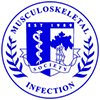Authors: Ketonis C, Aiyer A, Shapiro IM, Parvizi J, Adams CS, Hickok NJ
Title: Vancomycin Modified Bone Allograft Provides Long Term Protection from Staphylcoccus
Institution: Thomas Jefferson UNiversity, Philadelphia PA
Purpose: We have previously described a novel covalent addition of antibiotics to bone allograft surfaces to minimize bacterial colonization. We now show that this surface is stable over time and withstands multiple challenges with Staphylococcus aureus (SA).
Methods: Allograft modification: Morselized human bone was washed and coupled: 2X with excess Fmoc-aminoethoxyethoxyacetate; deprotected with 20% piperidine in Dimethylformamide; followed by vancomycin (VAN). VAN Stability: Control or VAN-Bone allograft, stored in PBS at 37°C was assayed for VAN at 15, 30, 45, and 60 days after synthesis. Samples were incubated with rabbit anti-VAN IgG (4?C, 12h), followed by AlexaFluor 488-coupled goat anti-rabbit IgG (1hr), and visualized by confocal laser microscopy. Fluorescence Quantification: Equal dry weights of Control or Van-Bone stored in PBS, 37?C, for 15, 30, 45, and 60 days were stained for VAN, washed, incubated with 7M urea for 12-16 h to dissociate the antibody complex and the released fluorescent antibody was measured using a Tecan plate reader. Elution Kinetics: Bone was modified with fluorescent dansyl-glycine modified VAN (dVAN- bone) or dVAN was adsorbed onto control unmodified bone. The adsorbed and dVAN-bone were inc ubated in PBS, 37?C for up to 3 weeks and eluted dVAN measured daily. The samples were then challenged with SA for 4hrs and assayed for colonization. Stability in media: Control or Van-Bone was incubated in PBS, dH2O, DMEM with 10%FBS, SA in TSB or left dry for 7 days, washed and stained for VAN. Bacterial challenges: Control or Van-Bone stored in PBS at 37?C for 15, 30, 45, and 60 days after synthesis were sterilized with 70% ethanol, rinsed with PBS, and incubated with S. aureus (Ci=10^4 cfu) in trypticase soy broth (TSB), 37?C, for 4 hours. Non-adherent bacteria were removed by washing and adherent bacteria stained with the Live/Dead BacLight Kit (viable bacteria fluoresce green) and visualized by confocal microscopy. Repeated bacterial challenges: Samples that have been challenged with SA were shaken in PBS overnight, followed by intermittent sonication/shaking in PBS, 1 hour, to remove attached bacteria. Cleaned bone surfaces were rechallenged with SA up to 7 times! repeating this procedure.
Results: Stability of VAN: VAN-bone, stained at 15, 30, 45 and 60 days post-synthesis, showed bright uniform fluorescence at each time point, where controls showed only the background fluorescence of bone. The fluorescence was quantified and the VAN-bone supernatant was 2-3 times more intense than that from control bone at all time points. Furthermore, VAN-bone fluorescence was unaffected by incubation in various physiologically relevant media for 7 days. Elution: Control dVAN-adsorbed bone released most of the VAN within the first week whereas the modified bone showed minimal if any release of the attached dVAN. When challenged at the end of the elution, dVAN-modified bone remained clear of SA as opposed to dVAN-adsorbed bone, which was heavily colonized. Antibiotic activity: VAN and control bone were challenged with SA 15, 30, 45 and 60 days after synthesis and assayed by fluorescent imaging. At all times, control bone was abundantly colonized with areas of biofilm formation; VAN- bone showed little colonization. Similar results were observed when the same VAN-bone was challenged multiple times indicating that a single molecule of VAN remains active even after multiple exposures to bacteria.
Discussion and Conclusion: Bone graft use continues to increase and infection rates remain signficant.Because bony allografts lack immune surveillance in the period before integration, they are rendered prone to infection which can compromise the allograft structural function and can result to serious complications (chronic osteomyelitis, bacteriemia, sepsis). Currently used techniques that attempt to address this problem, such as antibiotic impregnation, fail to provide long-term protection due to their rapid elution. In this report, we have described a novel surface modification on bone grafts that renders them bactericidal over long periods of time. The covalent chemical bonding is stable under different conditions and even remains attached after an initial assault with bacteria, potentially allowing coverage for multiple attacks by infectious organisms. We have shown that this technology is superior to current antibiotic delivery systems such as antibiotic incorporation, remedying some of the shortcomings such as unpredictable elution kinetics, lack of long-term activity, and potential systemic effects. These attributes can protect the modified allograft from infection for sufficient time to allow ingrowth and stabilization with the patient's bone.

